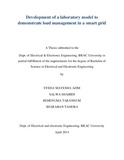| dc.contributor.advisor | Ahmed, Dr. S. Shahnawaz | |
| dc.contributor.author | Azim, Syeda Mayesha | |
| dc.contributor.author | Shahidi, Salwa | |
| dc.contributor.author | Tarannum, Rehenuma | |
| dc.contributor.author | Tahora, Sharaban | |
| dc.date.accessioned | 2014-05-14T10:28:53Z | |
| dc.date.available | 2014-05-14T10:28:53Z | |
| dc.date.copyright | 2014 | |
| dc.date.issued | 2014-04 | |
| dc.identifier.other | ID 10115002 | |
| dc.identifier.other | ID 10221068 | |
| dc.identifier.other | ID 10121014 | |
| dc.identifier.other | ID 10121093 | |
| dc.identifier.uri | http://hdl.handle.net/10361/3231 | |
| dc.description | This thesis report submitted in partial fulfillment of the requirement for the degree of Bachelor of Science in Electrical and Electronic Engineering, 2014. | en_US |
| dc.description | Cataloged from PDF version of Internship report. | |
| dc.description | Includes bibliographical references (page 32). | |
| dc.description.abstract | Vital to the evolution of a modern civilization is uninterrupted supply of electricity. However, in a resource constrained utility the large gap between demand and generation entails load shed i.e. tripping a feeder from the substation causing a total service disruption to the consumers under that feeder for an interval. An alternative is load management through demand response i.e. consumers will willingly reduce their consumptions on getting a signal on price or other incentives from the utility so that there is no need for shedding the total load of a consumer. This is one of the objectives of a Smart grid that aims to overlay ICT in the existing power grid and co-ordinate energy usage of individual consumers so that the generation and demand is balanced. In order to familiarize the smart grid concept to the consumers in general and future engineers in particular this thesis addresses the load management aspect through developing a laboratory model. Here the consumer end smart meter is represented by an Arduino Mega2560 microcontroller equipped with a NRF905 transceiver and interfaced with LEDs (which simulate loads). Another similar set of Arduino is interfaced with a computer to simulate the utility server. From the server a signal on the percentage of load to be turned off is transmitted to the client end. Within 10 seconds of receiving the signal a suitable combination of loads greater than or equal to the instructed percentage needs to be turned off by the consumer else the equivalent load will be turned off automatically by the smart meter. In either case the client (smart meter) transmits a feedback signal to the server. The way the model has been built and various codes are developed for control and communication is illustrated in this thesis. | en_US |
| dc.description.statementofresponsibility | Syeda Mayesha Azim | |
| dc.description.statementofresponsibility | Salwa Shahidi | |
| dc.description.statementofresponsibility | Rehenuma Tarannum | |
| dc.description.statementofresponsibility | Sharaban Tahora | |
| dc.format.extent | 79 pages | |
| dc.language.iso | en | en_US |
| dc.publisher | BRAC University | en_US |
| dc.rights | BRAC University thesis are protected by copyright. They may be viewed from this source for any purpose, but reproduction or distribution in any format is prohibited without written permission. | |
| dc.subject | Electrical and electronic engineering | en_US |
| dc.title | Development of a laboratory model to demonstrate load management in a smart grid | en_US |
| dc.type | Thesis | en_US |
| dc.contributor.department | Department of Electrical and Electronic Engineering, BRAC University | |
| dc.description.degree | B. Electrical and Electronic Engineering | |

